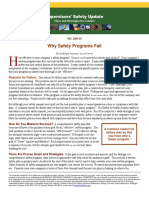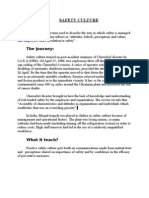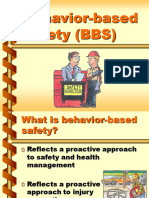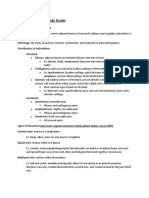Behavior-based Safety (BBS)
What is behavior-based safety
Reflects a proactive approach to safety and health management
Reflects a proactive
approach to injury
prevention
Focuses on at-risk behaviors that can lead to injury
Focuses on safe behaviors that can contribute to
injury prevention
BBS is an injury
prevention process
�Questions
Write short note on
• Behaviour based safety
� Principles of
behavior-based safety
• Focus intervention on observable behavior
• Look for external factors to understand/improve behaviors
• Direct with activators and motivate with consequences
• Focus on positive consequences to motivate behavior
• Apply the scientific method to improve intervention
• Use theory to integrate information, not to limit possibilities
• Design interventions with consideration of internal feelings and
attitudes
8a
� Implementation phases of BBS
• Phase 1 - assess the safety culture
• Phase 2 – educate and train team leaders
• Phase 3 - educate and train employees about
the principles, tools, and implementation
strategies
• Phase 4 - monitorthe progress
2a
� The corporate safety culture
• Develop a clear safety mission and goals
• Communicate the vision and goals
• Enable each area to attain its own safety
goals
• Encourage individual participation
• Empower employees to set and achieve
their own goals
• Foster mutual respect and support
3a
� Critical behaviors and barriers to safety
• At-risk behaviors that lead to serious injury or fatality
• At-risk behaviors that could lead to serious injury or
fatality
• At-risk behaviors that lead to a large number of minor
injuries or near misses
• At-risk behaviors that could contribute to a large number
of injuries because many people perform a given task
• Safe behaviors that need to occur consistently in order to
prevent personal injury
5a
� Motivation
Motivation is built on a solid corporate culture
• Some examples of motivational influences that
can take precedence over motivation include:
– an individual’s self worth
– a secure work environment
– desire for achievement
– desire for recognition
– how employees feel about their jobs in general
• Lack of motivation often centers around attitudinal
problems
• Address the motivational influences to increase
energy and enthusiasm
6a
� Motivation
• Key motivational points include:
– asking employees for their input
– holding morale-building meetings
– providing employees with the tools they need to do
their work
– recognizing personal needs
– providing employees with challenging tasks
– privately recognizing employees for good work
– fostering a sense of community at your facility
6e
� The “DO IT” process
• Define behaviors
• Observe behaviors
• Intervene
• Test the intervention
7a
� Summary
Behavior-based safety
• Reflects a proactive approach to safety and
health management
• Reflects a proactive approach to injury prevention
• Focuses on at-risk behaviors that can lead to
injury
• Focuses on safe behaviors that can contribute to
injury prevention
• Is an injury prevention process
9a

























































































